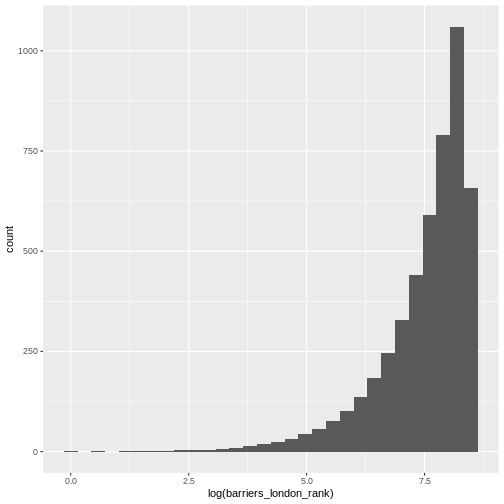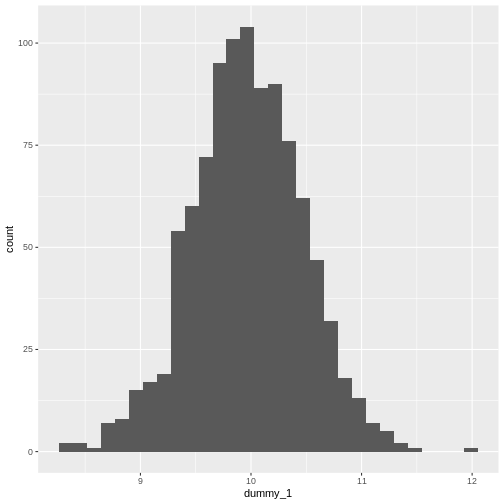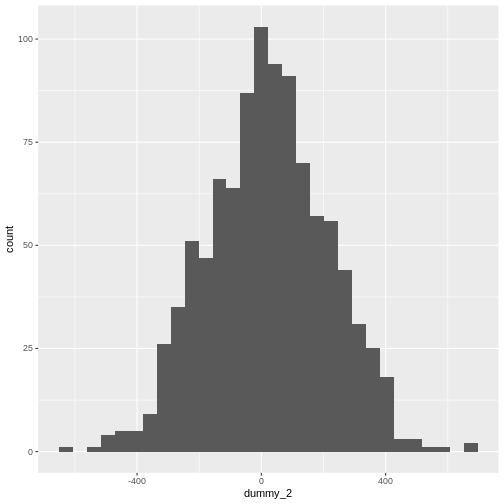Basic Statistics: describing, modelling and reporting
Last updated on 2025-11-11 | Edit this page
Overview
Questions
- How can I detect the type of data I have?
- How can I make meaningful summaries of my data?
Objectives
- To be able to describe the different types of data
- To be able to do basic data exploration of a dataset
- To be able to calculate descriptive statistics
- To be able to perform statistical inference on a dataset
Content
- Types of Data
- Exploring your dataset
- Descriptive Statistics
- Inferential Statistics
Data
R
# We will need these libraries and this data later.
library(tidyverse)
library(ggplot2)
# loading data
hgtwgt_survey <- read.csv("data/hgt_wgt.csv")
We are going to use synthetic data that has been generated based upon Health Survey for England, 2021 data tables.
The big picture
- Research often seeks to answer a question about a larger population by collecting data on a small sample
- Data collection:
- Many variables
- For each person/unit.
- This procedure, sampling, must be controlled so as to ensure representative data.
Descriptive and inferential statistics
Just as data in general are of different types - for example numeric vs text data - statistical data are assigned to different levels of measure. The level of measure determines how we can describe and model the data.
Describing data
- Continuous variables
- Discrete variables
How do we convey information on what your data looks like, using numbers or figures?
Describing continuous data.
First establish the distribution of the data. You can visualise this with a histogram.
R
ggplot(hgtwgt_survey, aes(x = weight.kg.)) +
geom_histogram()
OUTPUT
`stat_bin()` using `bins = 30`. Pick better value `binwidth`.WARNING
Warning: Removed 80 rows containing non-finite outside the scale range
(`stat_bin()`).
What is the distribution of this data?
What is the distribution of population?
If the raw values are difficult to visualise, so we can take the log of the values and log those. Try this command
R
ggplot(hgtwgt_survey, aes(x = log(weight.kg.))) +
geom_histogram()
OUTPUT
`stat_bin()` using `bins = 30`. Pick better value `binwidth`.WARNING
Warning: Removed 80 rows containing non-finite outside the scale range
(`stat_bin()`).
What is the distribution of this data?
Parametric vs non-parametric analysis
- Parametric analysis assumes that
- The data follows a known distribution
- It can be described using parameters
- Examples of distributions include, normal, Poisson, exponential.
- Non parametric data
- The data can’t be said to follow a known distribution
Describing parametric and non-parametric data
How do you use numbers to convey what your data looks like.
- Parametric data
- Use the parameters that describe the distribution.
- For a Gaussian (normal) distribution - use mean and standard deviation
- For a Poisson distribution - use average event rate
- etc.
- Non Parametric data
- Use the median (the middle number when they are ranked from lowest to highest) and the interquartile range (the number 75% of the way up the list when ranked minus the number 25% of the way)
- You can use the command
summary(data_frame_name)to get these numbers for each variable.
Mean versus standard deviation
- What does standard deviation mean?
- Both graphs have the same mean (center), but the second one has data which is more spread out.
R
# small standard deviation
dummy_1 <- rnorm(1000, mean = 10, sd = 0.5)
dummy_1 <- as.data.frame(dummy_1)
ggplot(dummy_1, aes(x = dummy_1)) +
geom_histogram()
OUTPUT
`stat_bin()` using `bins = 30`. Pick better value `binwidth`.
R
# larger standard deviation
dummy_2 <- rnorm(1000, mean = 10, sd = 200)
dummy_2 <- as.data.frame(dummy_2)
ggplot(dummy_2, aes(x = dummy_2)) +
geom_histogram()
OUTPUT
`stat_bin()` using `bins = 30`. Pick better value `binwidth`.
Calculating mean and standard deviation
R
mean(hgtwgt_survey$weight.kg., na.rm = TRUE)
OUTPUT
[1] 78.57195Calculate the standard deviation and confirm that it is the square root of the variance:
R
sdweight <- sd(hgtwgt_survey$weight.kg., na.rm = TRUE)
print(sdweight)
OUTPUT
[1] 18.95131R
varweight <- var(hgtwgt_survey$weight.kg., na.rm = TRUE)
print(varweight)
OUTPUT
[1] 359.1521R
sqrt(varweight) == sdweight
OUTPUT
[1] TRUEThe na.rm argument tells R to ignore missing values in
the variable.
Describing discrete data
In our data set there is a variable gender.M., where
there is a 1 this represents a Male, when there is a 0 this represents a
Female. What is the proportion of males and females in this data
set?
- Frequencies
R
table(hgtwgt_survey$gender.M.)
OUTPUT
0 1
471 529 - Proportions
R
gendertable <- table(hgtwgt_survey$gender.M.)
prop.table(gendertable)
OUTPUT
0 1
0.471 0.529 Contingency tables of frequencies can also be tabulated with table(). For example:
R
table(
hgtwgt_survey$gender.M.,
hgtwgt_survey$age.yrs.
)
OUTPUT
16-24 25-34 35-44 45-54 55-64 65-74 75 + 75+
0 70 70 64 80 89 86 11 1
1 66 100 84 101 77 90 11 0Which leads quite naturally to the consideration of any association between the observed frequencies.
Inferential statistics
Meaningful analysis
- What is your hypothesis - what is your null hypothesis?
Always: the level of the independent variable has no effect on the level of the dependent variable.
What type of variables (data type) do you have?
What are the assumptions of the test you are using?
Interpreting the result
Testing significance
p-value
<0.05
-
0.03-0.049
- Would benefit from further testing.
0.05 is not a magic number.
Comparing means
It all starts with a hypothesis
- Null hypothesis
- “There is no difference in mean height between men and women” \[mean\_height\_men - mean\_height\_women = 0\]
- Alternate hypothesis
- “There is a difference in mean height between men and women”
More on hypothesis testing
The null hypothesis (H0) assumes that the true mean difference (μd) is equal to zero.
The two-tailed alternative hypothesis (H1) assumes that μd is not equal to zero.
The upper-tailed alternative hypothesis (H1) assumes that μd is greater than zero.
The lower-tailed alternative hypothesis (H1) assumes that μd is less than zero.
Remember: hypotheses are never about data, they are about the processes which produce the data. The value of μd is unknown. The goal of hypothesis testing is to determine the hypothesis (null or alternative) with which the data are more consistent.
Comparing means
Let’s use the hypothesis introduced aboove: is there is a difference in mean height between men and women?
R
hgtwgt_survey %>%
group_by(gender.M.) %>%
summarise(mean = mean(height.cm., na.rm=TRUE), n = n())
OUTPUT
# A tibble: 2 × 3
gender.M. mean n
<int> <dbl> <int>
1 0 169. 471
2 1 170. 529Is the difference between the income ranks statistically significant?
t-test
Assumptions of a t-test
One independent categorical variable with 2 groups and one dependent continuous variable
The dependent variable is approximately normally distributed in each group
The observations are independent of each other
For students’ original t-statistic, that the variances in both groups are more or less equal. This constraint should probably be abandoned in favour of always using a conservative test.
Doing a t-test
R
t.test(height.cm. ~ gender.M., data = hgtwgt_survey)
OUTPUT
Welch Two Sample t-test
data: height.cm. by gender.M.
t = -0.4514, df = 905.12, p-value = 0.6518
alternative hypothesis: true difference in means between group 0 and group 1 is not equal to 0
95 percent confidence interval:
-1.868536 1.169731
sample estimates:
mean in group 0 mean in group 1
169.2433 169.5927 R
# we can also specify specific components
t.test(height.cm. ~ gender.M., data = hgtwgt_survey)$statistic
OUTPUT
t
-0.4513974 R
t.test(height.cm. ~ gender.M., data = hgtwgt_survey)$parameter
OUTPUT
df
905.1175 Notice that the summary()** of the test contains more data than is output by default.
More than two levels of IV
While the t-test is sufficient where there are two levels of the IV,
for situations where there are more than two, we use the
ANOVA family of procedures. To show this, we will
compare the height.cm. between age.yrs . If
the ANOVA result is statistically significant, we will use a post-hoc
test method to do pairwise comparisons (here Tukey’s Honest Significant
Differences.)
R
anovamodel <- aov(hgtwgt_survey$height.cm. ~ hgtwgt_survey$age.yrs.)
summary(anovamodel)
OUTPUT
Df Sum Sq Mean Sq F value Pr(>F)
hgtwgt_survey$age.yrs. 7 377 53.88 0.39 0.908
Residuals 912 125852 138.00
80 observations deleted due to missingnessR
TukeyHSD(anovamodel)
OUTPUT
Tukey multiple comparisons of means
95% family-wise confidence level
Fit: aov(formula = hgtwgt_survey$height.cm. ~ hgtwgt_survey$age.yrs.)
$`hgtwgt_survey$age.yrs.`
diff lwr upr p adj
25-34-16-24 -1.0876483 -5.441625 3.266328 0.9950252
35-44-16-24 0.7335528 -3.719044 5.186150 0.9996594
45-54-16-24 -0.4616277 -4.758755 3.835499 0.9999810
55-64-16-24 -0.6362741 -4.996295 3.723747 0.9998485
65-74-16-24 -0.2406692 -4.548669 4.067331 0.9999998
75 +-16-24 -1.3599122 -10.181699 7.461875 0.9997812
75+-16-24 -9.0785244 -44.916755 26.759706 0.9945770
35-44-25-34 1.8212011 -2.325669 5.968071 0.8856874
45-54-25-34 0.6260206 -3.353453 4.605495 0.9997495
55-64-25-34 0.4513742 -3.595933 4.498681 0.9999755
65-74-25-34 0.8469791 -3.144233 4.838192 0.9982202
75 +-25-34 -0.2722639 -8.943759 8.399232 1.0000000
75+-25-34 -7.9908761 -43.792408 27.810656 0.9975443
45-54-35-44 -1.1951806 -5.282322 2.891961 0.9870957
55-64-35-44 -1.3698270 -5.523043 2.783389 0.9741652
65-74-35-44 -0.9742221 -5.072794 3.124349 0.9963485
75 +-35-44 -2.0934651 -10.814895 6.627965 0.9961179
75+-35-44 -9.8120773 -45.625737 26.001582 0.9912530
55-64-45-54 -0.1746464 -4.160733 3.811440 1.0000000
65-74-45-54 0.2209585 -3.708160 4.150077 0.9999998
75 +-45-54 -0.8982845 -9.541376 7.744807 0.9999849
75+-45-54 -8.6168967 -44.411559 27.177766 0.9960472
65-74-55-64 0.3956049 -3.602201 4.393410 0.9999892
75 +-55-64 -0.7236381 -9.398170 7.950894 0.9999967
75+-55-64 -8.4422503 -44.244518 27.360017 0.9965272
[ reached 'max' / getOption("max.print") -- omitted 3 rows ]Regression Modelling
The most common use of regression modelling is to explore the
relationship between two continuous variables, for example between
weight.kg. and height.cm. in our data. We can
first determine whether there is any significant correlation between the
values, and if there is, plot the relationship.
R
cor.test(hgtwgt_survey$weight.kg., hgtwgt_survey$height.cm.)
OUTPUT
Pearson's product-moment correlation
data: hgtwgt_survey$weight.kg. and hgtwgt_survey$height.cm.
t = 5.7403, df = 843, p-value = 1.318e-08
alternative hypothesis: true correlation is not equal to 0
95 percent confidence interval:
0.1281856 0.2580185
sample estimates:
cor
0.1939512 R
ggplot(hgtwgt_survey, aes(weight.kg., height.cm.)) +
geom_point() +
geom_smooth()
OUTPUT
`geom_smooth()` using method = 'gam' and formula = 'y ~ s(x, bs = "cs")'WARNING
Warning: Removed 155 rows containing non-finite outside the scale range
(`stat_smooth()`).WARNING
Warning: Removed 155 rows containing missing values or values outside the scale range
(`geom_point()`).
Having decided that a further investigation of this relationship is
worthwhile, we can create a linear model with the function
lm().
R
modelone <- lm(hgtwgt_survey$weight.kg. ~ hgtwgt_survey$height.cm.)
summary(modelone)
OUTPUT
Call:
lm(formula = hgtwgt_survey$weight.kg. ~ hgtwgt_survey$height.cm.)
Residuals:
Min 1Q Median 3Q Max
-53.257 -11.782 -0.578 12.686 55.936
Coefficients:
Estimate Std. Error t value Pr(>|t|)
(Intercept) 26.37137 9.11826 2.892 0.00392 **
hgtwgt_survey$height.cm. 0.30844 0.05373 5.740 1.32e-08 ***
---
Signif. codes: 0 '***' 0.001 '**' 0.01 '*' 0.05 '.' 0.1 ' ' 1
Residual standard error: 18.44 on 843 degrees of freedom
(155 observations deleted due to missingness)
Multiple R-squared: 0.03762, Adjusted R-squared: 0.03648
F-statistic: 32.95 on 1 and 843 DF, p-value: 1.318e-08Regression with a categorical IV (the t-test)
Run the following code chunk and compare the results to the t-test conducted earlier.
R
hgtwgt_survey %>%
mutate(gender.M. = factor(gender.M.))
OUTPUT
id gender.M. age.yrs. weight.kg. height.cm.
1 1 1 55-64 84.37890 185.8997
2 2 0 75+ 51.53121 160.6946
3 3 0 65-74 84.96998 150.6249
4 4 1 16-24 72.02838 175.3232
5 5 1 25-34 70.87684 170.0324
6 6 0 45-54 79.60363 NA
7 7 0 55-64 48.71265 155.5181
8 8 0 16-24 82.29827 167.5624
9 9 0 25-34 68.04999 170.6217
10 10 0 16-24 80.13319 NA
11 11 1 45-54 88.40248 156.1628
12 12 1 45-54 47.75751 NA
13 13 0 55-64 70.97448 168.0705
14 14 0 25-34 68.54353 168.2886
15 15 0 65-74 43.77363 163.3694
16 16 0 16-24 57.00966 189.8100
17 17 1 55-64 84.64384 199.9218
18 18 1 65-74 72.35957 174.0487
19 19 0 55-64 124.23759 172.7415
20 20 0 35-44 85.07334 155.1350
[ reached 'max' / getOption("max.print") -- omitted 980 rows ]R
modelttest <- lm(hgtwgt_survey$height.cm. ~ hgtwgt_survey$gender.M.)
summary(modelttest)
OUTPUT
Call:
lm(formula = hgtwgt_survey$height.cm. ~ hgtwgt_survey$gender.M.)
Residuals:
Min 1Q Median 3Q Max
-30.849 -8.510 -0.703 7.232 41.153
Coefficients:
Estimate Std. Error t value Pr(>|t|)
(Intercept) 169.2433 0.5661 298.972 <2e-16 ***
hgtwgt_survey$gender.M. 0.3494 0.7749 0.451 0.652
---
Signif. codes: 0 '***' 0.001 '**' 0.01 '*' 0.05 '.' 0.1 ' ' 1
Residual standard error: 11.72 on 918 degrees of freedom
(80 observations deleted due to missingness)
Multiple R-squared: 0.0002214, Adjusted R-squared: -0.0008676
F-statistic: 0.2033 on 1 and 918 DF, p-value: 0.6522Challenge: Regression with a categorical IV (ANOVA)
Use the lm() function to model the relationship between
hgtwgtsurvey$height.cm. and
hgtwgtsurvey$age.yrs..
Compare the results with the ANOVA carried out earlier.
First we need to convert age.yrs. to a factor, then we
can create our model. If we compare the p-values for the Anova (0.908)
and the lm we have just created (0.9083) we can see that the outcome is
the same.
R
hgtwgt_survey %>%
mutate(age.yrs. = factor(age.yrs.))
OUTPUT
id gender.M. age.yrs. weight.kg. height.cm.
1 1 1 55-64 84.37890 185.8997
2 2 0 75+ 51.53121 160.6946
3 3 0 65-74 84.96998 150.6249
4 4 1 16-24 72.02838 175.3232
5 5 1 25-34 70.87684 170.0324
6 6 0 45-54 79.60363 NA
7 7 0 55-64 48.71265 155.5181
8 8 0 16-24 82.29827 167.5624
9 9 0 25-34 68.04999 170.6217
10 10 0 16-24 80.13319 NA
11 11 1 45-54 88.40248 156.1628
12 12 1 45-54 47.75751 NA
13 13 0 55-64 70.97448 168.0705
14 14 0 25-34 68.54353 168.2886
15 15 0 65-74 43.77363 163.3694
16 16 0 16-24 57.00966 189.8100
17 17 1 55-64 84.64384 199.9218
18 18 1 65-74 72.35957 174.0487
19 19 0 55-64 124.23759 172.7415
20 20 0 35-44 85.07334 155.1350
[ reached 'max' / getOption("max.print") -- omitted 980 rows ]R
modelttest <- lm(hgtwgt_survey$height.cm. ~ hgtwgt_survey$age.yrs.)
summary(modelttest)
OUTPUT
Call:
lm(formula = hgtwgt_survey$height.cm. ~ hgtwgt_survey$age.yrs.)
Residuals:
Min 1Q Median 3Q Max
-30.789 -8.427 -0.860 7.056 41.434
Coefficients:
Estimate Std. Error t value Pr(>|t|)
(Intercept) 169.7732 1.0814 156.992 <2e-16 ***
hgtwgt_survey$age.yrs.25-34 -1.0876 1.4332 -0.759 0.448
hgtwgt_survey$age.yrs.35-44 0.7336 1.4657 0.500 0.617
hgtwgt_survey$age.yrs.45-54 -0.4616 1.4145 -0.326 0.744
hgtwgt_survey$age.yrs.55-64 -0.6363 1.4352 -0.443 0.658
hgtwgt_survey$age.yrs.65-74 -0.2407 1.4181 -0.170 0.865
hgtwgt_survey$age.yrs.75 + -1.3599 2.9039 -0.468 0.640
hgtwgt_survey$age.yrs.75+ -9.0785 11.7968 -0.770 0.442
---
Signif. codes: 0 '***' 0.001 '**' 0.01 '*' 0.05 '.' 0.1 ' ' 1
Residual standard error: 11.75 on 912 degrees of freedom
(80 observations deleted due to missingness)
Multiple R-squared: 0.002988, Adjusted R-squared: -0.004665
F-statistic: 0.3904 on 7 and 912 DF, p-value: 0.9083- R has a range of in-built functions to enable initial data exploration.
- Linear models (lm) can be used with continuous and categorical variables.
